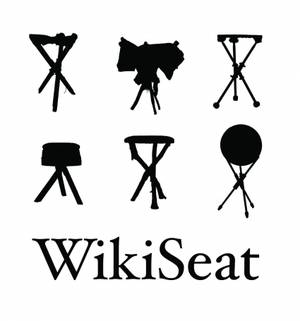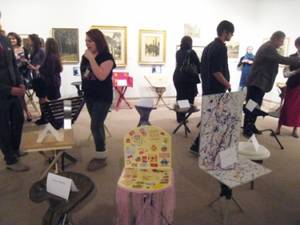Future Now
The IFTF Blog
Maker Education and The WikiSeat Project
If you are a student, a teacher, a maker, or a thinker, I'd like to invite you to participate in a project I've been developing called WikiSeat, and I truly believe this project can change the way students learn.

We all know education is changing. As our world grows in complexity and new networks are formed, traditional education just doesn't work as well is it used to. It simply isn't practical to teach students a series of facts that make up one worldview. What we need at this time is to teach students how to learn. Students do need to learn facts, but the focus needs to be on crucial skills such as critical thinking, communication, collaboration and creativity—the four C’s of 21st century education. Even the now widely-adopted idea of core STEM curriculum (Science, Technology, Engineering, Math) is evolving to STEAM, — the A standing for art — because STEM lacks the element of creativity.
These concepts are by no means new, but they’re also far from evenly distributed. One effort trying to address this disparity is Makerspace, an experimental program that brings the "maker experience" into the classroom. If you have never heard of the maker experience, just browse through some YouTube videos or come out to the East Bay Mini Maker Faire this weekend on October 14. This experience is all about engaging with puzzles and playing with objects. By doing this we learn, and we can actively solve real-world problems and discover new novel things. Makerspace is currently piloting the program with 16 highschools around California, and they will be scaling up to a national level next year.
Primary education is in dire need of programs like Makerspace. Since 1980, over 75% of shop classes have been cut due to budget problems in California alone. According to a report by CNN in 2010, 7,000 students were dropping out of High School everyday. This is equivalent to one student every 26 seconds[1]. Some people do just fine in school, sitting at the desk and taking tests. Still others struggle with this style of learning, I was lucky enough to have a teacher that taught architecture, design and engineering (thanks Mr. Burns). These classes, in addition to art (thanks Mr. Schall and Mrs. Parker), are the only reason I had any interest in staying in school. Not everyone in school is as lucky as I was.
These new education initiatives like STEAM and Makerspace are in their starting phases, and haven’t been widely adopted. Educators can start to experiment with new ways of teaching and learning on their own, but this can be daunting for educators who are being faced with pressure from school districts and parents to be everything to everyone. This brings us to WikiSeat.

WikiSeat started in Ohio while I was studying Design at Ohio State University. It was born from my desire to create a seat. One night I thought to myself, every designer eventually makes a seat, why don’t I make one now? I would have never imagined in my wildest dreams what started to happen afterwards.
I designed what is now known as the Catalyst, and distributed them to about 100 different people, asking them to make a seat of their own. This experiment was mildly successful, 20% of the people I gave Catalysts to built a seat. The rest had very interesting paperweights. The project sat still for about a year until Sean Wheeler saw WikiSeat posted on BoingBoing (thanks Pesco) and decided to try it out with his 10th grade American Literature class at Lakewood Highschool in Ohio.
Wheeler had a local welder fabricate 85 Catalysts, while he developed a corresponding lesson plan. He found that the students really enjoyed this style of learning, and that they were engaged and challenged while making their seats and this passion carried over to their writing. His student’s read Emerson’s “Self Reliance” and simultaneously created an object all of their own, they were able to apply an abstract concept to a real-world activity. Wheeler said after seeing the effect that this project had on his class, “My students really grew as writers because they were writing with real passion, a passion that was born from their wanting to tell a wider audience about their discoveries while working on the Wikiseats.”

That’s the magic behind WikiSeat; getting the abstract to appear tangible, and WikiSeat doesn’t have to stop with American Literature, this is an infinitely scalable idea. To quote Wheeler’s latest post on his blog:
“In perhaps the most provocative line in his ‘American Scholar’ speech, given in Cambridge, Massachusetts on August 31, 1837, Ralph Waldo Emerson makes a distinction between two conceptions of education. On one side, that of the ‘book-worm’, students are to go about the work of studying greatness. On the other side, and the one engaged by the WikiSeat project, is a conception of education that promotes thinking and the actual potential for greatness of the students…
…I want my students to become thinkers, not book-worms. I want students who not only study the views of those who have gone before them, but also students who put forth views of their own. In this digital age, with all of these outlets for speech and expression, I want students who can think critically about information, issues, and problems. I then I want them to communicate, collaborate, and create. And I want them to learn all of this by making a WikiSeat.”
If this is the sort of thing you are into, and if this is the future you would like to see, where we make our identities rather than purchase them, where we think about things rather than absorb them, join me in what has become my passion. The only way we are going to get the future we want is if we make it. Let’s start now.
Learn how to participate in the WikiSeat Project at wikiseat.org and follow us on twitter.



